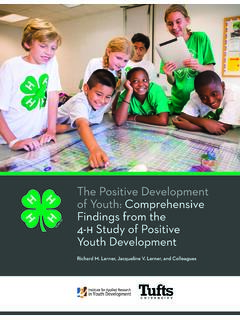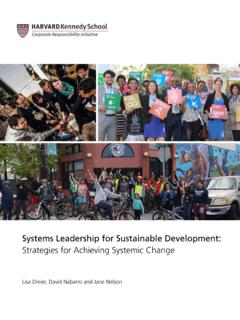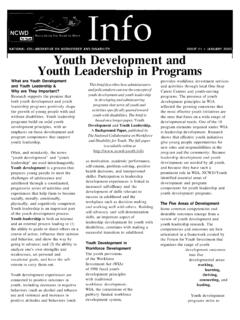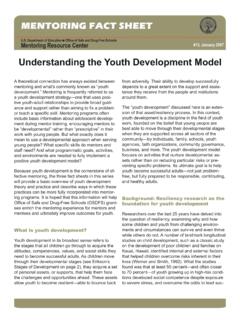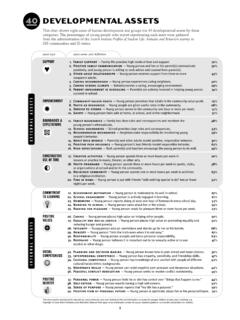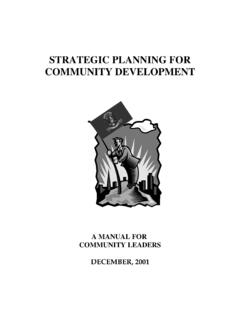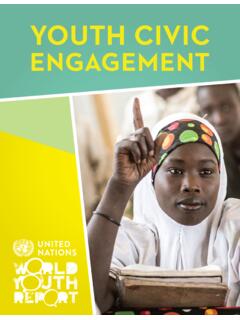Transcription of A Narrative for Youth Work Today - GOV.UK
1 A Narrative for Youth work Today : final draft for consultation 1 The key focus of Youth work is to enable young people to develop holistically, working with them to facilitate their personal, social and educational development , to enable them to develop their voice, influence and place in society and to reach their full potential, (National Occupational Standard 2008 italic emphasis added) An education for the 21st century: A Narrative for Youth work Today Why now? There are two reasons why the timing is ideal for a new understanding of the role Youth work , alongside formal education, parents, families and wider communities, plays in the personal and social development of young people and equips them with the resources they need to succeed . Such success we might define as finding a place within the community offering security, fulfilment and strong interpersonal relationships. The first is to inform the collaborative discussions of the Department for Education s Positive for Youth 1 process (a task for which the authors of this paper have been commissioned), complementing the work being undertaken by the Centre for Analysis of Youth Transitions.
2 The second is more complex and relates to the shared understanding of the aspirations we have for young people, for them to accept, embrace and excel in fulfilling those responsibilities that emerge with age, and how these can be realised within the current social and economic context. This paper is intended for two audiences. The first is policy makers and commissioners operating at national and local levels. Though our primary intention here is to prompt debate, a future action would be to develop specific guidance to support policy and commissioning processes in understanding how Youth work contributes to effective interventions and improves the lives of young people. The second audience is Youth work practitioners and those with an interest in supporting them in particular educators (see appendix 2), the Youth workforce, Youth sector not-for-profits and other stakeholders - for whom we hope this paper sparks discussion around the contemporary value of Youth work and how that is appropriately articulated.
3 Youth work : approaches & outcomes In this paper we promote the view that Youth work is a highly effective approach for supporting personal and social development (the process by which we learn from our experiences and develop the skills and competences to enable us to become more effective in our decisions and relationships) and developing the social and functional capital2 necessary to empower young people. We contend that through this process the outcomes and success we all want to see for young people can be realised. Youth work is a distinctive practice sitting alongside formal education, parenting, family and the wider community, in providing the teaching, learning and development young people need to make successful transitions to adulthood. In supporting such successful and safe transitions Youth work confronts some key challenges: 1 (DfE, 2011) 2 Identity formation, agency an culture: A social psychological synthesis (Cot and Levine, 2002) A Narrative for Youth work Today : final draft for consultation 2 Learning - the need to develop a wider and more inclusive learning and development offer that addresses the breadth of experience and opportunities young people need to flourish, providing structures to recognise that and to encourage lifelong learning; The changing nature of employment - illustrated by calls for employability skills such as customer awareness, self-management and problem-solving3.
4 Although overall attainment gaps are narrowing and grades improving, a persistent group of those still not in employment, education or training4 (NEET) indicates some young people are being left behind. Even allowing for churn within NEETs5 the UK is still behind other countries in tackling Family and community to help young people find an active and responsible role and place within the community - offering security, fulfilment and strong interpersonal relationships with family, local communities and other citizens in order to support a connective and associative society. Human approaches to these issues are not naturally given, but require understanding and abilities learned with peers and supportive adults concerned with them and their development . Some of this learning is the remit of the school (especially in regard to specific skills for employment), but we believe there is a more inclusive learning and development offer - Youth work , that address the breadth of experience young people need to flourish into accomplished and confident adults.
5 To take employment as just one example: good Youth work can help young people deal with career choices realistically, balancing their expectations (from basic security through to fame and wealth) against new financial realties (the costs of further/higher education and a more volatile labour market). Good Youth work is essential to ensuring young people Today can cope with a set of transitions very different to those faced by their parents. What is Youth work ? The Youth work approach is person-centered, empowers young people and transfers easily into different contexts. Its practice is informed by a set of values 7 that include young people opting in voluntarily, creativity and reflection, respect, equity, diversity, independence and many others. Crucially this in turn helps young people to develop their own values. Though not unique to Youth work the power of relationships with peers and supportive adults is an important element. Group work is also a common approach.
6 The model below is just one way of demonstrating its flexibility and responsiveness, illustrating degrees of Youth work interventions using the nature of stimuli (events) and levels of self and guided reflection. In addition Youth work can take place in a wide range of settings including Youth clubs, sports/arts clubs, faith or uniformed groups and many others. Different young people require different approaches, settings and institutional contexts from highly targeted, specialist support to a more universal offer. Youth work approaches offer such flexibility. In the borough of Knowsley for example different services for young people are provided /commissioned according to the needs of specific geographical areas, issues affecting particular groups of young people or a more universal demand. Some activities target anti -social behaviour hotspots , where detached Youth workers gather intelligence before engaging young people in programmes focusing on risky behaviour.
7 Others such as Teenage Health in Knowsley (THinK) run a programme for young women at risk of teenage pregnancy and sexual health problems. At the other end of the spectrum Youth Zones provide universal activities delivered in secondary Centres for Learning across the borough on Friday evenings, aiming to provide a wide range of positive activities for those aged 13-19 years. 3 (CBI, 2011) 4 (Third Sector Foresight, 2011) 5 Increasing Participation Understanding Young People who do not Participate in Education or Training at 16 and 17 (NfER, 2009) 6 Education at a glance (OECD, 2010) 7 (National Occupational Standards p194) A Narrative for Youth work Today : final draft for consultation 3 Above: Degress of intervention and reflection in Youth work , based on the Oginsky model (original version available via the link below). 8 But Youth work in its entirety is much more than a range of services, activities and interventions.
8 Though Youth work methodologies and approaches can be taken into other (non- Youth work ) contexts, there are elements of Youth work itself that mean it is more than simply one way of working with young people. Some of these elements are to do with professional skills and levels of training, but others touch on what Howard Sercombe refers to as the covenantal relationship of trust 9 that Youth workers build with young people, that society accepts the need for appropriate adults to develop such relationships in order to support young people s development - and indeed authorises them to do so. What does Youth work practice look like? To put simply Youth work practice engages young people in meaningful personal and social development processes which are challenging, rewarding and enjoyable. Youth workers facilitate the abilities of young people to think, act, change, create and grow, making a difference to their own lives, those of their peers and communities.
9 Whilst Youth work practice can be difficult to briefly summarise its various forms have a family resemblance , characteristics including: 1. Young people choose to be involved in the activity or program. They help to plan and design it and are involved in its evaluation and implementation. Activity design starts where young people are. 8 Cumulative diagram based on Oginsky model available in original version at (Oginsky, 2011) 9 (Sercombe, Youth work Ethics, 2010) A Narrative for Youth work Today : final draft for consultation 4 2. The process involves collective activity ( team work ) and the facilitation of learning that enables young people to develop social skills and competences facilitating progression to independent adulthood - young people working together, learning and reflecting as a group, using a variety of different mediums (art, debate, media, curriculum resources etc).
10 3. The programmes are in and of themselves enjoyable, challenging and rewarding to young people, who are encouraged and supported to influence the delivery of the programme, take on leadership roles and responsibilities for tasks. 4. The programme affords young people the opportunity to think about themselves as individuals and groups in relation to wider issues and encourages reflection. 5. The programme/process provides further development opportunities for young people, through the creation of resources/curriculum tools that can be used by others, the opportunity for peer education, or inclusion in local and national forums or debates. 6. There is sometimes recognition for involvement in the process and celebration of achievement, accreditation or acknowledgment by a wider group, community. 7. There is an increase in the confidence, self esteem and voice of young people as a result of the programme/process. These seven characteristics are also often expressed as steps ( Hart s Ladder of Participation10) or as spiral journeys where the young person s role evolves each time they go round (from participant through to higher forms of engagement).











